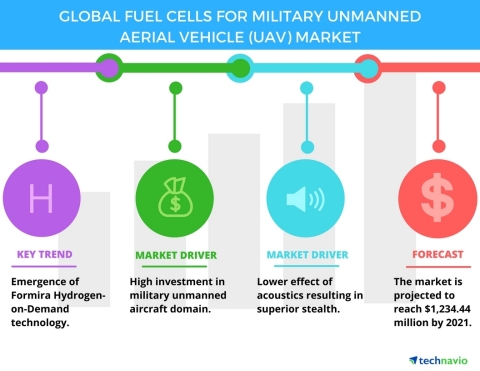Fuel Cells for Military Unmanned Aerial Vehicle Market - Drivers and Forecasts by Technavio
Technavio analysts forecast the global fuel cells for military unmanned aerial vehicle (UAV) market to grow at a CAGR of over 14% during the forecast period, according to their latest report.
This press release features multimedia. View the full release here: http://www.businesswire.com/news/home/20171024005994/en/

Technavio has published a new report on the global fuel cells for military unmanned aerial vehicle market from 2017-2021. (Graphic: Business Wire)
The research study covers the present scenario and growth prospects of the global fuel cells for military UAV market for 2017-2021. A fuel cell is a device that generates electricity through an electrochemical reaction. In this process, oxygen and hydrogen are combined in the presence of an electrolyte to generate clean energy.
Unmanned aircraft are being increasingly used in military applications, such as collection of real-time information, videos, and images, which help in strategic and tactical decision making. They are being preferred over manned aircraft in missions that involve risk to human lives. Further, the use of fuel cells in military UAVs renders them with greater endurance, fuel efficiency, and stealth capabilities than conventional UAVs.
This report is available at a USD 1,000 discount for a limited time only: View market snapshot before purchasing
Buy 1 Technavio report and get the second for 50% off. Buy 2 Technavio reports and get the third for free.
Technavio analysts highlight the following three factors that are contributing to the growth of the global fuel cells for military UAV market:
- High investment in military unmanned aircraft domain
- Lower effect of acoustics resulting in superior stealth
- Adoption of fuel cells to decrease dependency on imported oil
Looking for more information on this market? Request a free sample report
Technavio’s sample reports are free of charge and contain multiple sections of the report including the market size and forecast, drivers, challenges, trends, and more.
High investment in military unmanned aircraft domain
Various public bodies around the world are investing heavily in the defense sector to ensure that it has adequate technological capabilities and advanced vehicles to combat any foreign threats. This has attracted many countries to sign agreements that involve procurement of sophisticated vehicles and ammunitions.
Ramyabrata Chakraborty, a lead defense research analyst at Technavio, says, “The continuous improvement in technology and involvement from various industry leaders have made the development of fuel cells for UAV successful. For instance, China-based MicroMultiCopter Aero Technology developed a military drone, HyDrone 1800, which features a next-gen hydrogen technology that allows it to operate in extreme weather conditions with efficiency.”
Lower effect of acoustics resulting in superior stealth
Currently, drones play an important role as an indispensable weapon as they deliver high-resolution reconnaissance, long-distance precision strikes, and are capable of aerial combat. It also enhances stealth characteristics as radars do not capture the radio waves transmitted by UAVs. This property can be used for deep surveillance missions in any external environmental conditions.
“The principle working behind fuel cells is a chemical process known as hydrolysis, where fuel and oxygen act as electrodes and are passed through the electrolyte to produce electricity. This reaction is free of combustion, which produces less noise during the functioning of UAVs and makes them a perfect stealth machine,” adds Ramyabrata.
Adoption of fuel cells to decrease dependency on imported oil
Conventional UAVs use gasoline or jet fuel for their operations. Gasoline and kerosene are non-renewable resources, which are gradually depleting globally. The continuous use of such non-renewable energy makes them scarce. The increasing demand for these fuels, which have limited their supply makes these fuels expensive. Due to depletion of fossil fuels, researchers are looking for alternative sources of fuel that will help power UAVs.
Non-renewable resources are mainly concentrated in certain areas around the world from where they are imported by other regions for a certain price. Due to the drastic depletion of non-renewable resources, their prices have gone higher. This might also affect the overall economy of the country. The alternative sources are being examined and adopted by various countries to decrease the dependence on foreign oil and become self-sufficient.
Top vendors:
- EnergyOR Technologies
- Horizon Fuel Cell Technologies
- MicroMultiCopter Aero Technology
- Protonex
- Ultra Electronics
Browse Related Reports:
- Global Defense Tactical Radio Market 2017-2021
- Global Active Protection System (APS) Market 2017-2021
- Global Signal Intelligence System Market 2017-2021
About Technavio
Technavio is a leading global technology research and advisory company. Their research and analysis focuses on emerging market trends and provides actionable insights to help businesses identify market opportunities and develop effective strategies to optimize their market positions.
With over 500 specialized analysts, Technavio’s report library consists of more than 10,000 reports and counting, covering 800 technologies, spanning across 50 countries. Their client base consists of enterprises of all sizes, including more than 100 Fortune 500 companies. This growing client base relies on Technavio’s comprehensive coverage, extensive research, and actionable market insights to identify opportunities in existing and potential markets and assess their competitive positions within changing market scenarios.
If you are interested in more information, please contact our media team at media@technavio.com.
View source version on businesswire.com: http://www.businesswire.com/news/home/20171024005994/en/


